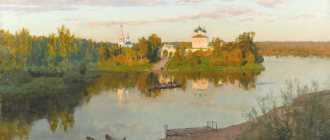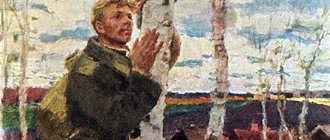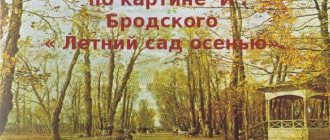Where was the painting painted?
Work on the work was completed by the author in 1894. During the creation of his masterpiece, Levitan stayed at Lake Udomlya in the Tver region. The landscape he saw was taken as a basis, as it hooked the artist with its calmness and simultaneous depth. The nature there is spacious, saturated with oxygen and herbal smell.
It’s so quiet in a remote corner of Russia that it’s already ringing in your ears. In his work, Isaac Ilyich wanted to reflect his own emotions. It is known that the landscape painter was prone to depression . The sensitive and vulnerable artistic nature could not ignore such views that Levitan captured in the picture about eternal peace. But the work was created not under the vault of heaven, but in the master’s studio.
The meaning and significance of the work
Russian landscape painters of the 19th century constantly talked about their ideas for subjects to each other. They wrote about this to patrons and comrades. Isaac Ilyich was no exception. The initial description of Levitan's painting was voiced by himself.
Here's what the master said about his work:
- the picture will be painted from a bird's eye view;
- below you can see a cemetery, personifying the eternal peace of people who have passed away;
- those at rest are contradicted by living nature, symbolizing eternity;
- eternity is presented as something terrifying, capable of consuming everything around;
- nature dominates over man, whose life is short, and he himself is weak and short-lived;
- The endless space is relieved by a small church where a small light burns.
It is worth noting that the church is not fictional, but copied from life. The author of the painting captured the building in Ples, and then transferred it to canvas. Eternity has not been kind to the building. The church is dilapidated. It is interesting that three years after the artist’s death, it burned down.
It is not surprising that such depressive thoughts visited the creator of a masterpiece of Russian art of the 19th century. Levitan constantly thought about peace. Death followed on his heels, as he had a congenital heart defect. But the reviewer's emotions may not coincide with the creator's thoughts.
Then it was believed that a person is just a small grain of sand in a huge world. Now people think differently. Therefore, the work inspires and calms contemporaries rather than frightens.
Over eternal peace. Essay based on Levitan's painting
Photography is a modern art that can replace painting. Why, like Alexander Andreevich Ivanov, wrote “The Appearance of Christ to the People” for 20 years? You can just take a photo and then go about your business. But only painting can reflect an entire eternity in one moment.
The proof of this thesis is one greatest masterpiece. “Above Eternal Peace” is one of the most famous paintings by the great Russian artist Isaac Levitan, painted by him in 1894. Then the Artist was at the peak of his career, the painting was a stunning success.
Let's take a closer look.
A small church, a huge leaden sky, a tiny cemetery and an endless expanse of water. The sketch of the canvas remains in the Tretyakov Gallery to this day. The visitor, involuntarily stopping in front of the painting, thinks about life, about himself, about his place in this huge, fleeting world, feeling like just a grain of sand in this unbridled world.
The size of the painting is 150×206 cm, which also speaks of its monumentality, it is slightly elongated horizontally and this ratio of proportions allowed the artist to achieve panoramic views and, most importantly, depth of the canvas.
If we talk about the color scheme, it is quite gloomy, although the sketch of the painting, which was used as the basis for the canvas, written in 1893, is even gloomier. The colors in the picture predominate, mostly cold, but there are also warm colors, creating contrast.
In the foreground, the church and cemetery are the only mention of human presence on the canvas, the cape clearly stands out in the foreground, and in the background there is a huge lake and a crazy heavy sky. But our visitor does not divide the picture into plans and does not think about colors and tones; he has time to remember and touch eternity.
The painting itself reflects the period of the artist’s life from 1888-1890, his stay in the city of Plyos for three summer seasons and reflects his melancholy and loneliness at that time. A cemetery with crooked crosses, a small church taken from the sketch “Wooden church in Plyos at the last rays of the sun” evoke sad thoughts, but only a small light in this church gives hope.
Here are mixed: fear, and the greatness of nature, and escape from the bustle of this world, and the inevitability of repeating the scenario of human life - all over again. In one of his letters to P. M. Tretyakov, Levitan wrote about his painting: “Eternity, a terrible eternity, in which generations have drowned and will drown again... What horror, what fear!” It is impossible to say for sure whether it is summer or late spring.
Twilight and a small light in the church, in all this greatness and fear, simultaneously direct a person to God. In all the bustle of the world, the pressure of circumstances, even the most terrible troubles, there always remains a ray and a thin path to the Almighty, for help and advice. And even in the most terrible and wild loneliness, a person is still not alone.
This is exactly what the picture screams about. But now our visitor is already running away, plunging into the turmoil of the problems and affairs of our fleeting life.
Source: https://kartina.ru/nad-vechnyim-pokoem-sochinenie-po-kartine-levitana/
The picturesque dignity of the canvas
Looking at the painting “Above Eternal Peace,” you immediately feel the author’s original style, visible in the sophistication of forms and the ability to stop time on the canvas. Thin strokes and miniature tree trunks immediately identify the artist.
Plants do not appear in close-up view of the viewer. But the sophistication of the form is undoubtedly present - a cloud floating against thunderclouds, an island offshoot, a path to a church.
Space acts as the main character of the picture. The lake and the sky are separated by a horizontal stripe.
The skyline performs a triple function - it creates the effect of the immensity of space, unifies the plot, and draws you into the plot.
The author tries to show the unfriendliness of natural eternity with the help of cold shades.
Interesting facts about creation and sale
Levitan began his work on the painting “Eternal Peace” in 1893. At that time, he had to visit many places - the Garino estate on the Msta River, Trinity station, the Ushakov estate. All the landscapes the artist saw were taken as the basis for the composition of the canvas. In the course of studying the history of writing “Above Eternal Peace,” you can find out several surprising facts about the creation and subsequent fate of the work:
- The area was completely borrowed by the authors during a horseback riding trip near Lake Udomlya, located a few kilometers from Ostrovno.
- While creating his masterpiece, the author wrote graphic versions of sketches and pictorial sketches.
- The painting was done in oil on canvas. The size of the finished work is 150 by 206 centimeters. Nowadays the masterpiece of Russian art is kept in the State Tretyakov Gallery (Levitansky Hall).
- The work begun in the estate by the lake was continued by the artist in the Moscow studio. The final touch was the author's signature in the lower corner.
- The painting was exhibited for the first time at the 22nd exhibition of the Association of Traveling Art Exhibitions in St. Petersburg.
- Before the St. Petersburg exhibition, the work, as well as one of the sketches, were acquired by Pavel Tretyakov. The artist was pleased with this cooperation not because of the profitability of the business, but because the buyer was the first person to once appreciate the creative talent of Isaac Ilyich.
During the exhibition, the painting attracted a lot of attention from spectators and experts. Critics unanimously insisted that the image evokes mixed feelings and bewilderment. The philosophical idea was not understood at first. She was criticized, talking about the overvaluation and arrogant overrated title, the weakness of the pictorial composition.
Others talked about the innovation of artistic techniques, the search for a new path. Unfriendly and laudatory publications appeared in magazines every now and then.
“Above Eternal Peace” by Levitan – a philosophical masterpiece
The painting “Above Eternal Peace” is a landscape painting by Isaac Levitan, owned by the State Tretyakov Gallery. Made in oil on canvas measuring 150 x 206 cm.
Author of the picture
Isaac Ilyich Levitan (1860 – 1900) is a great Russian artist, master of poetic landscapes. Born in Lithuania into an educated but poor Jewish family, whose move to Moscow in the 1870s allowed their children, including Isaac, to receive a good education.
At the Moscow School of Painting, Sculpture and Architecture, Isaac’s teachers were Perov, Polenov, and Savrasov. According to the recollections of the artist’s contemporaries, Levitan worked with persistence and great endurance from a young age, mastering the art of art, although teaching came easily to him.
He never received an artist’s diploma, which did not stop him from creating hundreds of bright and soulful paintings, which are exhibited in the best museums in the world.
The landscape “Above Eternal Peace” is perhaps the most serious and thoughtful of all.
The history of the idea and the beginning of work
Levitan had many friends and acquaintances who were passionate about painting and were happy to provide the artist with their estates in the Tver and Vladimir provinces, where he could live and work. The artist also often went to the “dacha” for summer sketches and rented rooms in the owners’ estates.
In the village of one such estate owner, Ushakov, in the very outback of the Tver land on Lake Udomlya in 1893, the artist found a stunning and majestic view that struck him so much that Levitan, who prefers lyrical landscapes, could not respond. With enthusiasm and obsession, he threw himself into his work.
The full-scale sketches took only a few days. Then, locking himself in the workshop room of the landowner's estate, the artist plunged headlong into his work.
According to the memoirs of the biographer and researcher of Levitanov’s work, Evdokimov, the inhabitants of the estate even began to walk and talk more quietly - this was how the importance and significance of the master’s work was felt.
Duet of brush and piano
For a sensitive and thoughtful viewer, the painting “Above Eternal Peace” gives rise to musical associations. It is interesting that the artist worked on the painting to the sounds of symphonies: he asked his companion Sofya Kuvshinnikova to continuously accompany him - the music provided additional inspiration.
In one of the two rooms of the estate they rented there was an old, but good-sounding harpsichord - on it the artist’s muse played Liszt and Chopin for hours. But most often the Heroic Symphony of Beethoven was played, some parts of which, with their emotional intensity, brought the impressionable genius to mental suffering and tears.
The extreme aggravation of feelings helped the artist to convey them through the brush onto the canvas and reflect a special drama in it.
The grandiose work is finished
Throughout the summer of 1893, from morning until late evening, Levitan worked on the canvas. Several sketches and studies for the painting were created. In the fall, the canvas was transported to Moscow. Upon completion of the work in early 1894, the artist signed an autograph, and the exhibition life of the canvas began, immediately acquired by Pavel Tretyakov for his gallery. Levitan himself was very proud and happy about this fact.
Description of the artwork “Above Eternal Peace”
It’s as if a bird in flight glanced - from this angle the artist opens a wide panorama to the viewer. A significant part of the canvas is occupied by the sky: its light and blueness are increasingly replaced by clouds of menacing, harsh clouds that are thickening, foreshadowing an imminent storm. Far away on the horizon, their tension had already poured out like rain.
Distant meadows and fields are flooded. The water element is depicted in the same leaden iridescent tones, which enhances the majesty and severity of the picture. The surface of the water only shows its wary anticipation of an imminent storm with cold ripples.
The growing chaos in the sky brings unrest to the ground as the wind bends the trees, causing them to swing their branches furiously.
And amid this collision of three elements - air, water and earth - a feeling of doomed sadness and hopelessness clearly arises. And an understanding comes of the fragility of human life, its vulnerability to the will of the elements. So the cemetery crosses, lopsided with time, remind us that there is no outcome, and reinforce the feeling of nature’s indifference to human passions.
The master himself, in moments of despair, acutely felt this hopelessness and was horrified by the merciless and indifferent passage of time, when generations after generations drown and drown in eternity.
But still, the painting “Above Eternal Peace” is not about hopelessness. The old wooden church, darkened by time, which rises on a green hill overhanging the water, inspires optimism and hope. A bright path leads to the praying church, inside of which the cherished living flame glows, and the sky here is bright. So the human soul reaches out to the light and overcomes darkness and horror before death.
Subsequent events
In 1989, the painting was presented at an exhibition of Russian and Finnish artists. It took place first in Munich, then moved to Berlin, Cologne, Dusseldorf. Other works by Levitan were also exhibited there.
With the beginning of the Great Patriotic War, exhibits from the Tretyakov Gallery were taken to Novosibirsk, where the paintings were stored in an inadequately rebuilt theater building. Masterpieces of Russian art were returned to their homeland only in November 1944.
During all this time, the canvas was not only part of the exhibition of the Tretyakov Gallery, but also visited many visiting exhibitions:
- in Moscow;
- in Leningrad;
- in Kyiv;
- In Minsk;
- on Krymsky Val;
- in the Vatican.
Now the canvas is part of the permanent exhibition of the Levitan Hall, located in the main building of the Tretyakov Gallery on Lavrushinsky Lane.
Description briefly
To write a good essay on Isaac Levitan’s painting “Above Eternal Peace,” you should arm yourself with a reproduction that can be downloaded from the Internet and printed. This will allow you to take a closer look at the details. In the picture, the viewer sees a gigantic reversal of a watery lake space with endless shores. At first glance, it seems that a flooding river is opening up in front of the observer. The wind has not yet died down; it carelessly drives swirling clouds and thunderclouds across the sky.
The horizon conventionally divides the canvas into two parts - a heavenly landscape opens above, and a cape with a church is visible below. The elevated bank is decorated with old, rickety crosses on graves overgrown with thick grass. The cemetery depresses the viewer. Nearby there is a church that fits harmoniously into the landscape. With soft movements and brush strokes, the artist vividly painted living nature - overgrown trees with lush greenery. The old building is not empty; a small light visible in the window speaks of life in it. This speaks of the resignation of a person unable to cope with an eternity of peace.
The casual asymmetry of the design is balanced by the contrasting direction of movement of each part of the image. The composition, seen by the artist with his own eyes, required an unusual pictorial solution. This helped to convey the immensity and power of the opening space as clearly and sharply as possible. One of the best landscape painters in Russia of the 19th century managed to convey his thoughts to the audience.
The inevitability of death is immediately felt and comprehended, while life continues, and you need to enjoy every moment while this is possible.
Essay based on Levitan’s painting “Above Eternal Peace”
Isaac Levitan's canvases are simple, understandable, but at the same time bright and attractive. The viewer is accustomed to seeing a riot of colors, movement, or some understanding that everything around lives and breathes.
But the artist has one painting that occupies a special place in his work. This is the painting “Above Eternal Peace”. In it, Levitan did not try to use eye-catching colors. He wanted the picture, first of all, to attract with its meaning.
This work literally turned the author’s soul inside out.
For the first time in his works, the artist chose exclusively cold shades to depict nature. Thanks to this, the viewer can feel a certain heaviness and contrition. The lake is calm and quiet. But because of this, his silence becomes even darker.
It seems that an image of death hangs over the picture. But a faint light in the church window gives life to the canvas. He proves that there is always a way out. And even in those situations when you are already giving up, you should believe that all is not lost. You always need to believe and strive forward.
Yes, life is fleeting, the clock cannot be stopped.
Does your teacher check for plagiarism? Order a unique work from us for 250 rubles ! More than 700 completed orders!
Order an essay
Those people who are buried in this now forgotten place once lived here, worked, created families, gave birth to children, loved and were loved.
They enjoyed their lives, and now there is almost no one left here - there is no one to really look after their last refuge.
Only the one who lit the light in the window of the church remained, and as long as he is alive, the memory of those people will be alive, and the light will light up every day in memory of the departed.
The picture makes you rethink your own actions, thinking about what trace you will leave behind in this world.
Looking at the boundless sky and the age-old lake, contrasted with the church and crosses that have almost disappeared from old age from the face of the earth, you understand that it is not important how long you have lived, because within the framework of the Universe it is just a moment, but how can you leave about yourself for the benefit of others? generations.
After all, it is the memory of a person who has already passed away that will fly invisibly over the crosses of such churches that replace each other over time, near the clouds of the same eternal sky.
Source: https://sochinyalka.ru/2017/03/sochinenie-po-kartine-levitana-nad-vechnym-pokoem.html









